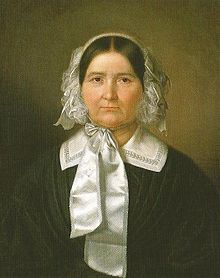Ludwig Sello
Christian Ludwig Samuel Sello , also Louis Sello (born February 21, 1775 in Potsdam ; † March 8, 1837 ibid) was a royal court gardener in Caputh and in the terrace area and the orangery area in the Sanssouci park in Potsdam .
Live and act
Ludwig Sello, called Louis, came from the second marriage of the royal gardener Johann Samuel Sello to the widowed Maria Louisa Wulf, née Kleist (1740–1791), daughter of the brewery owner Christian Kleist. He was born in the gardener's house below the Sanssouci Palace, where his father managed the kitchen garden, the so-called Marlygarten, and a greenhouse built on the current site of the picture gallery .
Like his stepbrother Carl , who was eighteen years his senior , Louis continued the family tradition and learned the gardening trade. After his apprenticeship , on June 29, 1793 from the Kgl. Garteninspection obtained a passport for his travels abroad and went on a hike that took him to Nymphenburg in December 1794 . At the electoral court he worked under the court gardener Johann Jacob Effner , who was responsible for the “Great or First Court Kitchen Garden”, which was not far from the Munich residence in Lehel , between the city fortifications and the Isar .
In 1796 his stepbrother, who had taken care of the kitchen garden as the father's successor, died. In anticipation of being able to take over the office, Louis Sello returned to Potsdam. However, the tree nursery gardener Joachim Heinrich Voss from Caputh had already been appointed as his successor , so that he took over the position of court gardener in the vacated Caputher district. After 14 years of activity, he handed over the office to Friedrich Nietner in 1810 and moved to Sanssouci in the terrace area, which the court gardener Johann Zacharias Saltzmann (1777-1810) had managed until then, who died in the same year . Sello's area of responsibility now comprised the six vineyard terraces on the south side of Sanssouci Palace. There he looked after the espalier fruit and the vines that grew on the walls and in the glazed niches of the retaining walls , as well as the espalier fruit above the walls and 84 orange trees in pots that stood between 96 Taxus pyramids in the summer months .
When the court gardener of the orangery area bordering the castle in the west, Anton Hillner (1749–1817) died, his position was saved and the area was placed under Sello in 1817. He was now additionally responsible for a 496 foot (156 m) long massive orange house, a 415 foot (130 m) long unheated cherry greenhouse (for cherries, wine, figs and apricots), a small one (only 296 feet - 93 m - long ) Orange house, a greenhouse with duct heating for cherries and wine, a fig wall, a small cherry greenhouse [and] a long fig wall at the temple of antiquities [...]. After his death, the eldest son Hermann took over the combined districts and expanded them into a large nursery that stretched from the New Chambers on the west side of the castle to the bend in Maulbeerallee, the west side of today's Botanical Garden .
family
Louis married Sello (1780-1858), daughter of the Berlin Dänischleder- and on 15 October 1799 Johanna Dorothee Charlotte Anger morocco -Fabrikanten Friedrich Wilhelm Anger. The marriage resulted in eleven children, two of whom were trained as a gardener.
Ludwig Hermann , born in 1800 , who later became court gardener in Sanssouci in the Charlottenhof park area and in the terrace area, also laid out the private “Sello cemetery” on Bornstedter Friedhof in 1844 , which was intended for family members and close friends. Ludwig Emil Walter , born in 1816, was appointed court gardener in various areas “outside of Sanssouci”, at the New Palais and the Charlottenhof park area. Both received the honorary title "Oberhofgärtner".
One of his daughters, the Albertina, born in 1803, called Berta (also Bertha) , married Theodor I. Nietner , who was also a court gardener at Paretz Palace and Niederschönhausen . Pauline, born in 1808, married the “architect of the king” Ludwig Persius .
When Louis Sello died in 1837, like his wife later, he found final rest in the Bornstedt cemetery .
See also
Family tree of the gardener family Sello (extract)
literature
- Foundation Prussian Palaces and Gardens Berlin-Brandenburg (Ed.): Prussian Green. Court gardener in Brandenburg-Prussia . Henschel, Potsdam 2004, ISBN 3-89487-489-9 , p. 332
Individual evidence
- ^ Georg Sello : Potsdam and Sans-Souci. Research and sources on the history of the castle, town and park . Breslau 1888, SX
- ^ Rainer Herzog: Court gardener in Bavaria . In: SPSG: Preußisch Grün , p. 36.
- ↑ Gerd Schurig: The fruits of the court gardeners . In: SPSG: Nothing thrives without care. The Potsdam park landscape and its gardeners . Potsdam 2001, p. 291.
| personal data | |
|---|---|
| SURNAME | Sello, Ludwig |
| ALTERNATIVE NAMES | Sello, Louis; Sello, Christian Ludwig Samuel |
| BRIEF DESCRIPTION | Royal gardener in Sanssouci |
| DATE OF BIRTH | February 21, 1775 |
| PLACE OF BIRTH | Potsdam |
| DATE OF DEATH | March 8, 1837 |
| Place of death | Potsdam |

